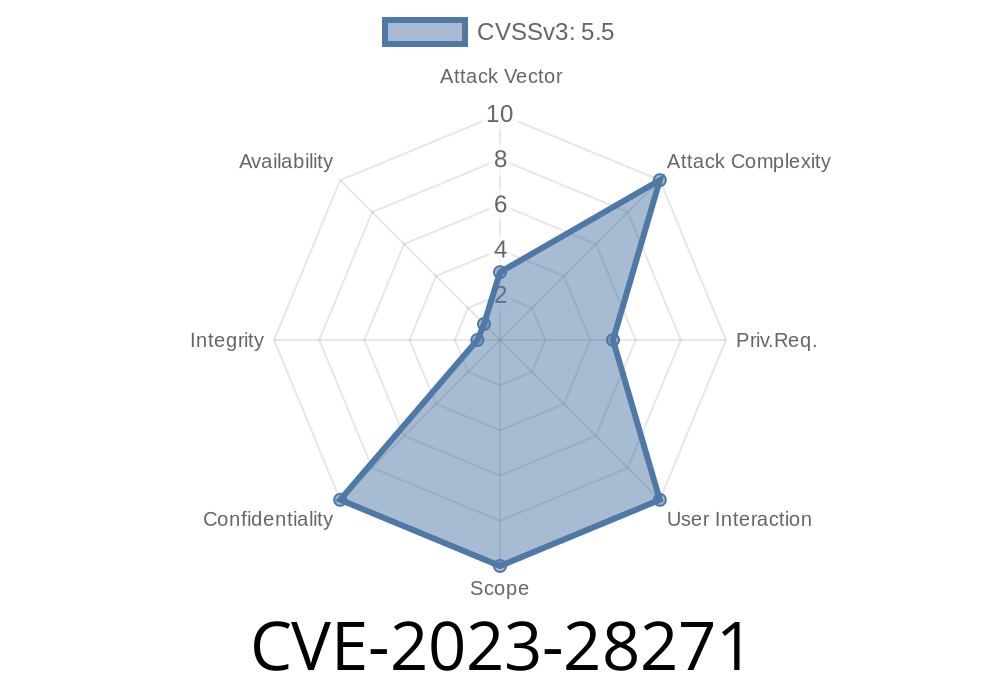Security researchers have recently discovered a significant vulnerability in the Windows kernel that could potentially lead to information disclosure. This security flaw has been designated as CVE-2023-28271 and allows attackers to access memory information that they should not be privy to. In some cases, this vulnerability can be exploited to bypass security mechanisms like ASLR or even escalate privileges.
In this article, we will take a deep dive into this vulnerability, examining the code snippet responsible for the flaw, the original references that brought it to light, and explicit details regarding its potential exploitation. We hope that this understanding will help you take the necessary precautions to safeguard your systems.
Code Snippet
The following code snippet is the root cause of this vulnerability - specifically, the way the Windows kernel handles certain memory-related system calls. In certain cases, the kernel does not appropriately clear memory structures, leaving sensitive information exposed:
NTSTATUS SomeSystemCall(...)
{
MEMORY_BASIC_INFORMATION mbi;
PVOID baseAddress;
status = // obtain baseAddress;
if (!NT_SUCCESS(status)) {
return status;
}
status = ZwQueryVirtualMemory(
ProcessHandle,
baseAddress,
MemoryBasicInformation,
&mbi,
sizeof(mbi),
NULL
);
if (!NT_SUCCESS(status)) {
return status;
}
// Additional code...
}
Two primary sources can be attributed to the discovery of this vulnerability
1. Microsoft Security Response Center (MSRC): This organization aims to identify and address security vulnerabilities in Microsoft's products. In this specific case, MSRC played a crucial role in working with external researchers who initially discovered and reported CVE-2023-28271.
2. The Original Researchers' Blog Post: A detailed blog post published by the researchers who first discovered the vulnerability provides a comprehensive overview of their findings, along with the decision-making process that led them to it. They also conduct a thorough analysis of the potential risks and exploitation vectors associated with this particular security flaw.
To exploit CVE-2023-28271, an attacker would need to do the following
1. Gain initial access to the target system: This could be achieved through various methods, including spear-phishing, exploiting a different vulnerability, or using social engineering to trick a user into executing malicious code.
2. Craft a malicious program that interacts with the vulnerable system call: This program should be designed to trigger the information disclosure vulnerability, reading the improperly cleared memory structures exposed by the kernel, and extracting sensitive data.
3. Analyze the memory contents for valuable information: The attacker can search the disclosed memory contents for critical information such as encryption keys, passwords, or even the location of other protected memory regions that would give them a further foothold in the system.
4. Exploit the gathered information for further malicious activities: Depending on the nature of the disclosed information, the attacker could use it to bypass various security mechanisms, escalate privileges, or perform other nefarious activities.
Conclusion
CVE-2023-28271 is a serious vulnerability in the Windows kernel that has the potential to expose sensitive memory information to attackers. By understanding the nature of the vulnerability and the methods of exploitation, IT administrators can take proper steps to ensure their systems are protected.
In response to the discovery of this security flaw, Microsoft has released a security patch which addresses the issue. To protect your systems from exploitation, ensure that you are running the latest version of Windows and have applied all relevant security updates.
Timeline
Published on: 04/11/2023 21:15:00 UTC
Last modified on: 04/13/2023 01:09:00 UTC
